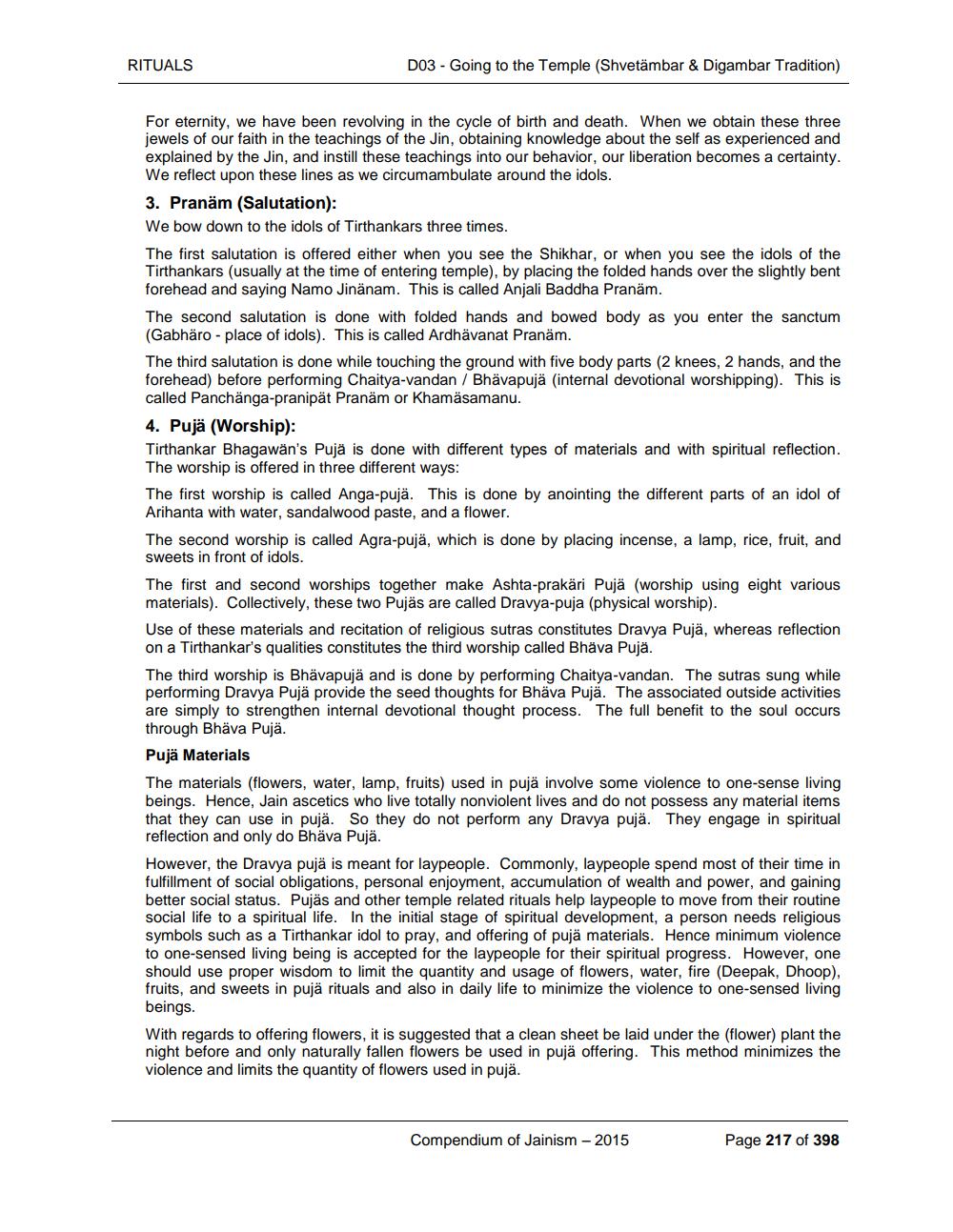________________
RITUALS
D03 - Going to the Temple (Shvetämbar & Digambar Tradition)
For eternity, we have been revolving in the cycle of birth and death. When we obtain these three jewels of our faith in the teachings of the Jin, obtaining knowledge about the self as experienced and explained by the Jin, and instill these teachings into our behavior, our liberation becomes a certainty. We reflect upon these lines as we circumambulate around the idols.
3. Pranam (Salutation):
We bow down to the idols of Tirthankars three times.
The first salutation is offered either when you see the Shikhar, or when you see the idols of the Tirthankars (usually at the time of entering temple), by placing the folded hands over the slightly bent forehead and saying Namo Jinänam. This is called Anjali Baddha Pranäm.
The second salutation is done with folded hands and bowed body as you enter the sanctum (Gabhäro - place of idols). This is called Ardhävanat Pranäm.
The third salutation is done while touching the ground with five body parts (2 knees, 2 hands, and the forehead) before performing Chaitya-vandan / Bhävapujä (internal devotional worshipping). This is called Panchänga-pranipät Pranäm or Khamäsamanu.
4. Pujä (Worship):
Tirthankar Bhagawan's Pujä is done with different types of materials and with spiritual reflection. The worship is offered in three different ways:
The first worship is called Anga-pujä. This is done by anointing the different parts of an idol of Arihanta with water, sandalwood paste, and a flower.
The second worship is called Agra-pujä, which is done by placing incense, a lamp, rice, fruit, and sweets in front of idols.
The first and second worships together make Ashta-prakäri Pujä (worship using eight various materials). Collectively, these two Pujäs are called Dravya-puja (physical worship).
Use of these materials and recitation of religious sutras constitutes Dravya Pujä, whereas reflection on a Tirthankar's qualities constitutes the third worship called Bhäva Pujä.
The third worship is Bhävapujä and is done by performing Chaitya-vandan. The sutras sung while performing Dravya Pujä provide the seed thoughts for Bhäva Pujä. The associated outside activities are simply to strengthen internal devotional thought process. The full benefit to the soul occurs through Bhäva Pujä.
Pujä Materials
The materials (flowers, water, lamp, fruits) used in pujä involve some violence to one-sense living beings. Hence, Jain ascetics who live totally nonviolent lives and do not possess any material items that they can use in pujä. So they do not perform any Dravya pujä. They engage in spiritual reflection and only do Bhäva Pujä.
However, the Dravya puja is meant for laypeople. Commonly, laypeople spend most of their time in fulfillment of social obligations, personal enjoyment, accumulation of wealth and power, and gaining better social status. Pujäs and other temple related rituals help laypeople to move from their routine social life to a spiritual life. In the initial stage of spiritual development, a person needs religious symbols such as a Tirthankar idol to pray, and offering of pujä materials. Hence minimum violence to one-sensed living being is accepted for the laypeople for their spiritual progress. However, one should use proper wisdom to limit the quantity and usage of flowers, water, fire (Deepak, Dhoop), fruits, and sweets in pujä rituals and also in daily life to minimize the violence to one-sensed living beings.
With regards to offering flowers, it is suggested that a clean sheet be laid under the (flower) plant the night before and only naturally fallen flowers be used in pujä offering. This method minimizes the violence and limits the quantity of flowers used in pujä.
Compendium of Jainism - 2015
Page 217 of 398




